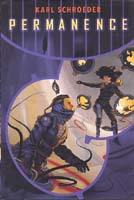 Permanence
Permanence
by Karl Schroeder
A book review by Mark L. Olson
Tor, 2002, $27.95, 446 pp
Karl Schroeder's first book, Ventus was quite good and Permanence matches it, a very impressive debut. Both books are solid SF, not super technical, but excellent adventures set in hard SF worlds.
Permanence takes the recent discovery of brown dwarf stars and extrapolates it most brilliantly into a really great SF setting. Brown dwarfs are midway between planets and stars: they're very massive – many time Jupiter's mass – but not massive enough to sustain thermo-nuclear fusion. Whatever heat they emit is heat derived from potential energy released when they coalesced. While they would not glow brightly, a brown dwarf would quite likely emit a lot of IR and a planet in very near orbit around a brown dwarf might well be warm enough for life.
Imagine a world with no sun, just stars and an enormous dark disc, perhaps 20 times the apparent size of the Moon glowing a dull red, or perhaps much larger, spanning most of the sky and not glowing visibly at all, but radiating warmth. Such a world might well be warm enough for liquid water and human colonization yet be a world of perpetual night. (It would be tide-locked so the brown dwarf's disk would never move in the sky.)
We haven't discovered planets around brown dwarfs yet, but as far as we know, they should exist.
There is good reason to believe that brown dwarfs may be more common than the visible stars, possibly a lot more common. Given slower-than-light travel, where would people settle? Around the rare bright star with years between worlds or around the brown dwarfs with other inhabited worlds only a few months away?
In Schroeder's world, mankind has populated hundreds or thousands of brown dwarf planets and a vast slower-than-light civilization has grown up. The civilization's ethos is one of permanence, a philosophy of attempting to create a civilization which will last forever. The monks of permanence run the Cycler Compact which links the worlds together. The cyclers are huge stl spaceships which follow a many-year-long loop around a string of planets, linking them together.
This civilization has lasted a thousand years at least, but the recent discovery of an ftl drive that only works in a deep gravity well has opened the Galaxy to mankind, but cut off the whole brown dwarf civilization as they are not massive enough to allow hyperdrive jumps to originate in their systems. The Cycler Compact is coming apart as commerce moves to ftl between the lit stars and the brown dwarf civilization slowly founders.
Rue Cassels is a young woman who escapes from her abusive brother and her life on a remote comet-mining station, setting out to a brown dwarf planet in hopes of finding a better life. On her way, she is the first to sight an unexpected cycler coming into the system, realizes that it is derelict and claims it as her own.
Things get complicated with a xenoarcheological team which is trying to understand why all known aliens have gone extinct, a military team from the lit stars trying to study the derelict, and various factions within the brown dwarf civilization all vying for control.
One aspect I particularly liked is the unfolding xenoarcheological understanding of the many extinct races of aliens. All races, once they discovered the hyperdrive inevitably split into warring factions (some even into warring species) as they spread through the Galaxy – the Galaxy is simply too big for a galactic civilization to exist as a whole.
A quite satisfying adventure later, everything works out well. This is a first-rate SF adventure!
(My only real complaint is that the cyclers as described are an absurdity – going an appreciable fraction of the speed of light, there is no way that they could be bent into a closed loop only a few tens of lightyears in circumference – they'd just fly right out of the Galaxy, since that's well above galactic escape velocity.
(Secondly, the idea that they would unload cargo by sending it down laser beams which would power the cargo's braking into a system, and then pick up cargo that was boosted back to speed using the same lasers simply won't work. Long before the cargo gets slowed down to planetary speeds, the cycler must have passed by – there will never be time for something to slow down, stop on the planet and then catch up again unless the catch-up speed is an even bigger fraction of lightspeed than the cycler's.)
(None-the-less this is very well done and Schroeder's ignorance (or ignoring) of orbital mechanics is easily excused given what a fine story this is.)
Highly recommended!
NESFA homepage | Review Index | More Reviews by Mark L. Olson
